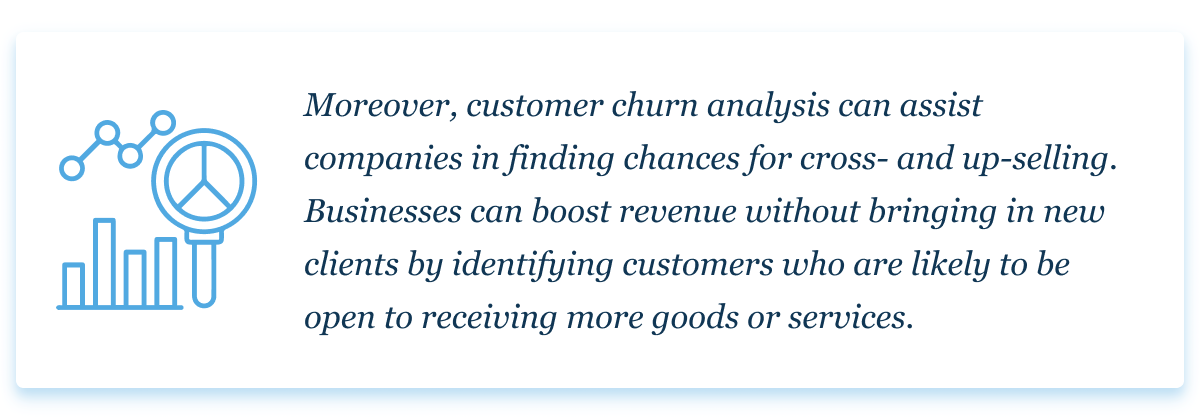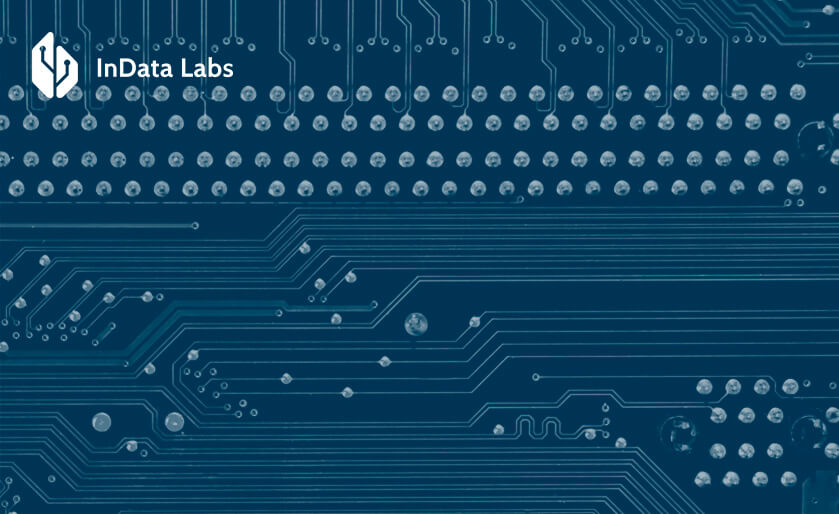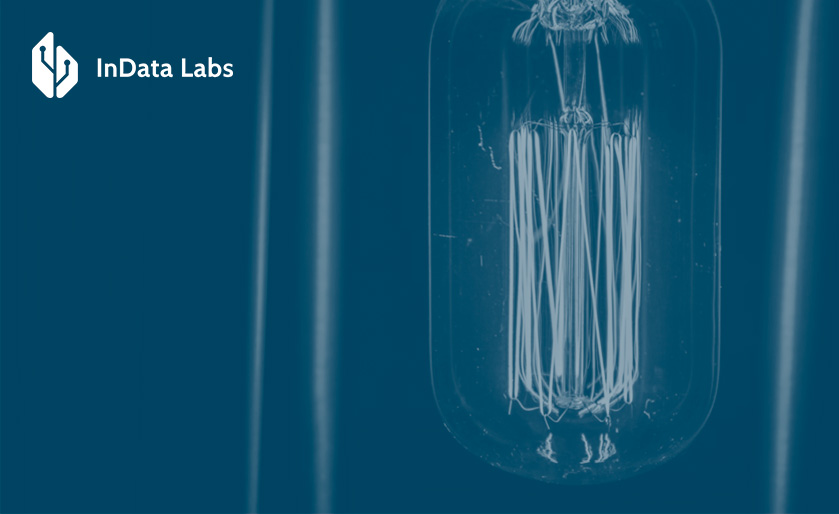Customer churn is a measurement that shows how many clients discontinued a service, an application or stopped buying a product during a certain period of time. Churn prediction is one of the most popular applications of machine learning and data science in business.
Although at first, churn analysis was essential for telecoms, now it is applicable for businesses of all sizes, including startups. Marketers with tight budgets are strongly relying on strategies build around churn and retention, considering such strategy the most cost-efficient.
Importance of churn analysis
On average, most company’s business comes from existing customers and acquiring the new ones is 15 times more expensive than retaining existing customers.
Churn analysis is mostly applicable in the following areas:
- For subscription-based businesses churn is a critical metric as every customer they lose results in the loss of recurring revenue.
- E-commerce companies are highly interested in providing their customers with timely communication without overspending on discounts and special offers for people who were not really about to churn.
Individualized customer retention solution could be a good idea. But being very time and money consuming it’s almost impossible to implement since businesses cannot spend much time on each of their multiple customers. On the other hand, knowing that a particular customer is about to churn, you could direct the retention efforts directly on her.
Why businesses use customer churn prediction
Since the question “what is customer churn analysis”, it’s time to move to why it is leveraged by business across industries.
Businesses employ customer churn analysis to comprehend consumer behavior better, spot opportunities for development, cut expenses associated with client acquisition, boost revenue, and gain a competitive edge. Businesses can proactively address consumer complaints and maintain long-term success by regularly conducting churn analysis. Let’s examine how forecasting client churn might be advantageous.
Better retention strategies
Creating more targeted and effective retention strategies is one of the main advantages of customer churn prediction analysis. By examining customer data, which enables them to spot trends and patterns in consumer behavior, businesses may better understand the needs and preferences of their customers.
Customer churn analysis in retail
Showroomprive.com, a top European E-commerce website, has implemented predictive analytics for effective churn management. Their data science solution involves establishing identification rules for potential churners and assigning a value to each customer at risk of churning. With this data, they have managed to accurately target personalized marketing campaigns to these customers, improving their chances of retention. Implementing churn detection has enabled Showroomprive.com to communicate with potential churners more timely and relevantly, resulting in increased win-back success rates.

Source: Unsplash
Weak points identification
A further advantage of customer churn analysis is that it enables companies to identify areas where their services might be improved. By examining customer feedback and complaints, businesses can identify typical customer issues or pain areas. Through better addressing consumer demands in their products and services, organizations can increase customer satisfaction and retention rates.
Resultful use case of customer churn analysis in the banking industry
One real-life customer churn analysis case study comes from Barclays, a multinational investment bank and financial services company based in London, UK that leveraged bank customer churn prediction using machine learning. In order to reduce customer turnover in its retail banking sector, Barclays developed a predictive churn model that looked at information such as demographics, transaction history, and behavior patterns.
Low levels of engagement, frequent balance queries, and an abundance of customer service calls were among the primary indicators the model found as being linked to client churn. Utilizing bank customer churn prediction data, Barclays created focused retention measures for clients who were at risk, such as providing tailored incentives and discounts.
Budget saving and higher revenue
Analysis of customer attrition can also aid in cutting back on the expense of acquiring new clients. By identifying the key elements that affect client retention, businesses may create targeted retention strategies that reduce the need for new acquisitions. As a result, client acquisition costs may decrease, and overall profitability may rise.

Effective use of customer churn analysis in the telecom industry
XO Communications, a top-tier communications service provider in the United States, has been focused on elevating its service standards by leveraging customer churn analysis. Let’s view their customer churn analysis example.
For several years, XO has been using vast amounts of customer data, such as demographics, transaction history, calling patterns, and conversations with call center agents, to develop a comprehensive knowledge of each customer. To identify the most predictive variables for voluntary churn, they compiled over 500 data points and used advanced customer churn prediction software to analyze trends and correlations. By applying these insights to its current customer base, XO accurately predicts and proactively engages with the most valuable and profitable customers who carry the highest churn scores.
By revealing deeper insights into customer habits, finding trends, identifying prospective defectors, and enabling proactive actions to retain their most important clients, the adoption of customer churn analysis has saved XO millions of dollars. A major national provider of advanced broadband communications services and solutions, XO has drastically decreased its customer attrition rates by approximately 50% as a result of its use of predictive analytics.
Opportunity to compete
Data science customer analytics can provide companies with a competitive edge. Businesses may set themselves apart from their rivals and draw in and keep more customers by getting to know their clients better and being able to provide customized services and retention methods. This can help businesses establish a strong brand identity and maintain a loyal customer base.
Fruitful customer churn analysis in the insurance industry
In the insurance sector, Avanade—a partnership between Microsoft and Accenture—has used customer churn analysis with Power BI. Avanade has grown its operations and increased revenue due to the data on customer turnover obtained by learning valuable insights from researching customer and policy data.

Source: Unsplash
Forecasting and planning
Customer churn analysis can benefit firms, in addition to the ways already mentioned, by aiding in predicting and planning. Businesses can generate more precise sales projections and successful marketing plans by studying customer data to find trends and patterns in customer behavior.
 In conclusion, customer churn prediction analysis is helpful for companies trying to move toward a data-driven approach and boost their financial metrics by lowering customer churn. Businesses can proactively address customer concerns and ensure long-term success by conducting regular analyses as a part of AI-based customer service.
In conclusion, customer churn prediction analysis is helpful for companies trying to move toward a data-driven approach and boost their financial metrics by lowering customer churn. Businesses can proactively address customer concerns and ensure long-term success by conducting regular analyses as a part of AI-based customer service.
How to predict customer churn: churn prediction and analysis steps
The main goal of churn prediction is detecting which customers are likely to cancel a subscription to a service based on how they use it. The question “How to do customer churn analysis” can be answered in three major steps:
- Data gathering and preparation
- Building the predictive model
- Testing and validation of the model on real customers
Each of these steps includes a variety of acquired techniques and smaller steps necessary for the best possible result.
1. Data gathering and preparation
The first step of data gathering includes the process of “feature engineering”. In order to predict churn on a particular customer, he or she is compared to another similar group of customers. Such comparison is based on particular pieces of information called “features” about each group of customers. The features include information about customers’ demographics, interactions history with the service, and other customer information relevant to a particular case. For example, customer’s age, level of education, number of times he logged into the app, time since last login, device type, and etc.
2. Building the predictive model
When building a churn prediction model, one of the most critical steps is to properly define what churn actually is, and how it can be translated into a variable that can be used in a machine learning model. The definition of churn is totally dependent on the business model and can differ widely from one company to another.
In order to effectively analyze and control customer churn, it is important to build an effective and accurate customer churn prediction model. Statistical and data mining techniques are utilized to construct the churn prediction models. The data mining techniques can be used to discover interesting patterns or relationships in the data, and predict or classify the behavior. In other words, it is an interdisciplinary area with a general objective of predicting outcomes and employing sophisticated data processing algorithms to discover mainly hidden patterns, associations, and anomalies in customer data.
3. Testing and validation of the model on real customers
When the model is ready and it is ensured that it takes into account all the special needs of a particular business and its customers, the testing period starts. It normally takes up to a few months. The model is fine-tuned according to the results. Such custom-built models have a solid advantage compared to automatically generated models – they stay very flexible and can be developed according to each company’s growing demands.
Predicting customer churn: challenges possible
While customer churn prediction can deliver significant benefits to businesses, it can also present challenges that must be overcome in order to reap the rewards. Here are the four most significant challenges businesses encounter when they start thinking about predicting customer churn and how to address them.
Challenge 1: Sleepers
One common problem in churn detection is that businesses have long-term customers who signed up a while ago and haven’t looked for other options. This kind of customer experience is known as “sleepers.” Contacting them might cause them to cancel their membership or switch to a competitor.
From a customer churn analysis with a machine learning perspective, this is referred to as a false positive: labeling a loyal customer as someone who might churn. In businesses with many loyal customers, the cost of false positives can be high, as contacting these “sleepers” could cause many of them to cancel their subscriptions.
The solution is to do a value assessment: determine how many false positives might leave if offered a discounted rate. This lost revenue can then be factored into calculations to determine if it’s worth waking these customers up. However, this solution can be difficult to implement without customer experience consulting, leading to the next churn challenge.
Challenge 2: Churn may not be predictable from your data
Churn is a complex problem; people cancel their subscriptions for different reasons, like switching to a competitor’s product or reducing expenses. It might not be possible to detect a pattern or motivation of churn with the available data.
For instance, a student had a low-cost prepaid plan with poor network quality and no roaming. As they started working and traveling to the United States frequently, they needed better network quality and roaming and could afford a more expensive plan. Their life had changed, so they churned from the student plan. It’s difficult for mobile providers to know this from data alone.

Source: Unsplash
To tackle this problem, consult domain experts and involve them in exploring possible ML solutions to determine what can and cannot be predicted from the data available.
Challenge 3: Deploying often requires human trust
Data professionals often forget the human aspect of businesses. Before starting a churn detection project, consider how the results will be used. Will they trigger automated messages or inform a local agent to take action?
Asking people to take action based on your model requires human trust. Your model won’t be successful if your scores aren’t taken seriously or if people nit-pick specific data points instead of trusting the model.
Two solutions exist. First, teach end-users about models and why they can be trusted. This transforms them into data citizens. Second, use explainable AI algorithms like LIME or SHAP to provide a prediction and the reasoning behind the decision. This can increase people’s trust, but be careful if the reasoning is counter-intuitive to their expectations.
Challenge 4: Predicting churn is NOT the problem
The main idea is to prevent churn rather than merely predict it. Even if a company correctly identifies that a customer is about to churn, offering discounts may not be enough to retain them. Instead, companies should offer personalized plans that cater to the customer’s needs, which can help increase revenue. The best churn models predict customer churn and suggest actions to prevent it.
There are two options for implementing this: building separate models for different churn reasons or using two models to predict churn and suggest the best actions. Predictive analytics consulting may help to pick an option that will work best for your case.

Conclusion
Customer churn analysis allows to minimize acquisition costs and increase marketing efficiency, preparing a solid base for future marketing analysis and campaigns. Customer churn analysis opens new opportunities for cross-selling and upselling and serves as one of the starting points for customer-driven product development, keeping customers engaged and loyal over time.
Let InData Labs work on your customized churn prediction models
Schedule an intro call with our AI consulting experts to explore your business and find out how we can help.



